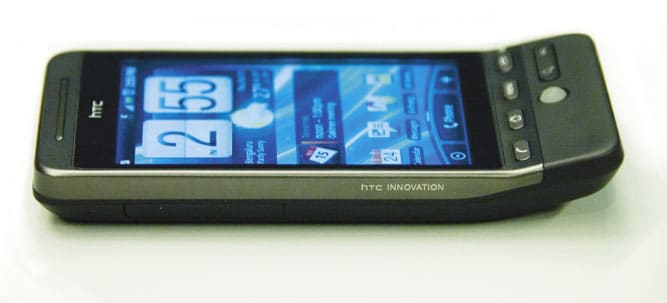
Phone: HTC Hero
The "Jay Leno Phone"
HTC Hero
OS: Android + Sense
11.2 cm x 5.62 cm x 1.435 cm, 135 gms, 8.1 cm TFT-LCD touch-sensitive screen with 320x480 HVGA resolution
Rs.: 32,000
The HTC Hero is a radical, beautiful phone. A crisp, bright glass touchscreen covers roughly most of its surface area; below it is a curious-looking “chin”(some call it the “Jay Leno phone”), with recessed buttons and a backlit trackball.
It fits comfortably into one’s palm, but the fat-thumbed will take time to get used to the cramped virtual keyboard, though “haptic feedback” (a slight buzz when you press a key) and the excellent automatic word prediction will help compensate. An oleophobic coating on the screen is supposed to repel oil-based smudges, like fingerprints; I found that it does still smudge, though not as readily as other phones. The back is Teflon-coated, to help preserve the finish. Over a week of normal use — leaving the phone on tables, car dashboards, floors — I was unable to detect even a minute scratch.
It runs HTC’s proprietary user interface, “Sense,” atop Google’s Android operating system.
Android is a radical departure from the way most of us have been using our phones: instead of relying on the manufacturer to provide all functions, we can get what we want via third-party applications. And Android gives you access to over 6000 applications by developers around the world. (Unfortunately, Google currently only allows developers to offer free Android apps in India, so much of the really good stuff is off limits.)
Sense adds a slick, user-friendly layer that simplifies routine tasks like calling, emailing, texting and web-browsing. Natural gestures — touches, flicks, swipes — open programs, shuffle songs and sort photos. It also integrates your contacts list with social networks like Facebook, Twitter and Flickr; your address book will show you names and numbers, plus profile picture, status messages, albums shared, etc. You can customise the home screen with various widgets and shortcuts. And if you run out of screen space, there are six extra home screens you can ‘swipe’ into view. It’s like having seven desktops.
The Hero does have some flaws. Seemingly unsure of an exclusively touchscreen interface, HTC has added five recessed buttons and a backlit trackball into the Hero’s manly chin. These buttons are awkward to press without having to look at them, confusing you unnecessarily. And while Sense handles routine activities seamlessly, some tasks can be painful. To see options for a particular item, you could wind up tapping the screen, pressing it for a few seconds or using the “Menu” button. And copy-paste isn’t available in all scenarios. The five megapixel camera isn’t great, especially compared to the Nokia N-series, and has no in-built flash. The in-built GPS is accurate and moderately fast, though it does tend to disconnect frequently. If you set the phone to constantly check email and other apps, its battery will die before the end of the day. With that much recharging, I suspect you’ll need to replace it within 12-18 months (it costs Rs.1200 plus taxes). Radiation (SAR) rating is 1.13, slightly at the higher end, so a handsfree device is a good idea.
Overall, a great phone, and a victory for good design, notwithstanding its flaws.
If you can afford the Rs.32,000 price tag, buy it.
(This story appears in the 30 November, -0001 issue of Forbes India. To visit our Archives, click here.)





